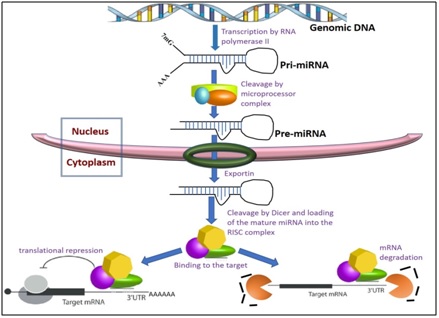The growth and productivity of crops is highly dependent on several environmental stresses such as soil pH and texture, climate change leading to high rainfall or drought, temperature extremities, insects, several pests and pathogens. Over the years, plants have evolved and developed several defence mechanisms to tolerate and protect themselves from such adverse conditions. MicroRNAs (miRNAs) are one such tool available within plants that they employ to recover from various stress responses.
MicroRNAs, as the name indicates, are small 20-24nt long non-coding ribonucleic acid molecules. They protect the plants against the pathogens by a process involving post transcriptional gene silencing, popularly known as RNA interference (RNAi) or Co-suppression. RNAi is a eukaryotic process that exploits the double-stranded RNA (dsRNA) to silence or switch off the expression of any undesirable gene (Figure 1).
The expression of a miRNA is inversely proportional to the expression of its corresponding gene. Several miRNAs have been found to be stress induced, causing the downregulation of the negative mediators of stress-tolerant genes. There are other miRNAs which get downregulated, upregulating the expression of stress-responsive genes. MiRNAs govern the expression of various transcription factors and other regulatory proteins as part of their defence response. Various approaches have been developed to modulate the miRNA expression in plants as well as in pathogens and RNAi is one of them.
RNAi has been approved as a potential strategy for crop protection against various pests and pathogens. It has been a method of choice to manipulate the genetic makeup of various crop species to provide resistance and produce genetically modified (GM) crops. However, the development of GM crops is time-consuming and expensive. The inability to genetically modify many crop species is posing another barrier to the use of transgenic technology. The partial success of the GM crops hence has demanded some other crop protection strategies which aim to deploy RNAi in a highly targeted manner. One such application of RNAi based technology for protecting crops is the topical application of double stranded (ds) RNA as a spray on crops. This method has been successfully demonstrated in controlling viral, fungal and insect damage in crop plants. The basic concept is to spray dsRNA of a gene from the target pest onto the leaf surfaces of host plant. This dsRNA activates the RNAi machinery of the target organism, resulting in co-suppression of that particular gene thus leading to its inactivation.
However, topical application of naked dsRNA provides only a small window of protection lasting just few days. A group of researchers, headed by Professor Neena Mitter from the University of Queensland have devised nano-sized degradable clay particles to carry and release the dsRNA in controlled manner. The strategy is also topical and entirely based on the phenomenon of RNA interference (RNAi). They used degradable clay particles such as layered double hydroxide (LDH) nanosheets in the form of a spray to deliver the dsRNA molecules onto the plant surface. The group has termed these dsRNA coated nano-particles as BioClay. Bioclay has emerged as a novel harmless alternative to insecticides and pesticides. This product has reported no adverse effect on human health as LDH is biocompatible, used in therapeutics and also gets degraded in mild acidic conditions.

Fig 2. Action of BioClay (Adapted from Fletcher et al., 2020).
The process of combining RNA with the clay is fairly simple. RNA being negatively charged sticks to positively charged clay particles. In the presence of atmospheric CO2 and moisture, LDH nanosheets slowly release the dsRNA on the leaf surface. As dsRNA is loaded onto the LDH it sticks to the leaf surface and does not get washed off for upto 30 days. It is a controlled-release mechanism in which the dsRNA is slowly and gradually released onto the leaf surface, entering into the plants and preparing them for future defence. The potential of BioClay as a crop protection strategy was confirmed by testing its efficacy using dsRNAs against pepper mild mottle virus (PMMoV) in tobacco and cucumber mosaic virus (CMV) in cowpea. The BioClay treated plants showed reduced viral infection in comparison to the untreated plants.
This exogenous application of dsRNA is all set to become the next-step in crop protection technology. As this technology is further refined, it will emerge as an important straightforward tool to protect plants from pests and pathogens, without causing any environmental degradation. Such RNAi based products are definitely the need of the hour and miRNAs are the new rising molecules that can be utilized for development of agronomic crops with high productivity and other desirable characteristics.
References
Fletcher, S. J., Reeves, P. T., Hoang, B. T., & Mitter, N. (2020). A perspective on RNAi-based biopesticides. Frontiers in Plant Science 11: 51.
Koch, A., Biedenkopf, D., Furch, A., Weber, L., Rossbach, O., Abdellatef, E., et al. (2016). An RNAi-based control of Fusarium graminearum infections through spraying of long dsRNAs involves a plant passage and is controlled by the fungal silencing machinery. PloS Pathogens 12(10): e1005901.
Mitter, N., Worrall, E. A., Robinson, K. E., Li, P., Jain, R. G., et al. (2017a). Clay nanosheets for topical delivery of RNAi for sustained protection against plant viruses. Nature Plants 3: 16207.
Mitter, N., Worrall, E. A., Robinson, K. E., Xu, Z. P., and Carroll, B. J. (2017b). Induction of virus resistance by exogenous application of double-stranded RNA. Current Opinion in Virology 26: 49–55.
Rosa, A., and Brivanlou, A. H. (2009). MicroRNAs in early vertebrate development. Cell Cycle 8(21): 3513-3520.
San Miguel, K., and Scott, J. G. (2016). The next generation of insecticides: dsRNA is stable as a foliar-applied insecticide. Pest Management Science 72: 801–809.
Song, X., Li, Y., Cao, X., & Qi, Y. (2019). MicroRNAs and their regulatory roles in plant–environment interactions. Annual Review Of Plant Biology 70: 489-525.
